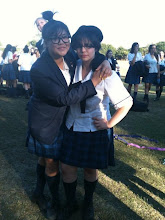They're a set of graphic images created by Alexia Sinclair called 'The Regal Twelve'. What she's done is that she's gathered twelve scandalous/infamous women in history and designed an artwork for each of them, telling their story through the symbolism in the images. I have read up on each womans story and I believe that Sinclair has done an awesome job in bringing these women back to life, especially for a more younger and modern generation, which I myself am apart of. But yeah, here they are:
Pregnancy: The birth of her famous son, King Richard the Lionheart
Armor & sword: The manner in which her children turned out
Door: The entrance to her tomb
Coat of Arms: Family symbolism
Battlefield: Her triumph as a female warrior
Helmet & sword: Symbolism of Roman mockery and defeat
Horse: Her Famous Chariot
Body Paint: Celtic Tradition
Snake: Her suicide
Wall Paintings: Egyptian Mythology
Scarab Beatles: They were used in Egyptian tradition to bejewel the bodies of the dead
Snakes: Symbolises the myth of how her son Alexander was concieved
Wind Blowing: Symbolises the God Zeus and his role in Alexander's existence
Golden Box: Symbolises her Husband, Philip
Bow & arrow: Her love of hunting and other male-based sports
The Mask: Represents the two different sides of her; The King and the Queen
Body paint & feathers: Symbolises the Goddess of the hunt, Artemis
The Wolf: Represents the hunt for her next victims
Moon: Signifies her love of the night
The colour red: Bood lust and her supposed killings
The Castle: Her home and future prison
The colour violet: Pride and vanity
The Quill: Her intelligence and illumination
The Icons: Her place amongst the greats
Russian eggs (Faberges): The past luxuries of the Russian court; decadence
Forest setting: Where the Romanovs' remains were left after they were murdered
Jewel encrusted gown: Signifies the jewels that were sewn into their corsets at the time of the shooting
Stance & facial expression: The disappearance of her daughter, Anastasia
Chess board: Her life and the many obstacles she faced; The strategic political actions she took
Radiance: Symbolises her 'Virginity'
Orb & sceptre: Her role as queen; reminiscent of her portrait
Painting: Siginifies her Christianity; Cathedral setting
Rosary beads & Bible: Once again, her religion
Her stance: Religious fanaticism
Model of a ship: The expeditions she entrusted to Christopher Columbus
The red quill: Death; the Spainish Inquisition
Chili: Signifies the new world
Her stance: Like a lioness, hence the inclusion of a lion
Mushroom: Her alleged use of a mushroom to poison Claudius
Lion: Also signifies Roman power and nobility
Arch: Roman civilisation
Slice of cake: The splendor and luxury of her life; decadence and excesses
Ballroom: French culture
Painting: The revolution which lead to Antoinette's demise; Napolean Bonaparte who took her place as emperor
I remember that the first one of these artworks I saw was the Catherine image, due to one of my good friends, Louisa, chosing to study her for a Modern History assessment. In her powerpoint she included that image, and I remember the whole class just gasping due to the sheer beauty of it.
Okay, so I've just talked about the symbolism in each one (or rather pin-pointed) but my favourites are certainly Isabella and Alexandra Romanov. The symbolism in them is just fantastic, specifically in the Romanov one. I liked how she used the Eggs to represent not only the luxuries of Russian nobility, but how it also led to the royal family's demise, which I found to be a very creative way to express the tragic story of the Tsar's downfall.
Anyway, these are a very lovely way to tell these womens' stories and to get people interested in the magic of history. If I could be bothered I would write a full paragraph about each woman's story, but sincerely, I can't. It's way too much effort.
Overall, Sinclair has done a great job in mixing traditional painting with digital design, but I, however, found myself least interested in Cleopatra. I don't know if it was the actual artwork or if the persona of Cleopatra never really interested me, but I think it may be the latter, due to the fact that the artwork actually is quite lovely and does represent Cleo as what she truly is... A tragic skank-face.
Anyway, I'm done for tonight. Thanks for reading and Till the next time.
Nadine xx

i agree, whe was quite a tragic skank face :)
ReplyDeleteamazing blog btw.
Elisabeth Bathory is still me fav.
ReplyDeleteYeah, she's up there. =)
ReplyDelete